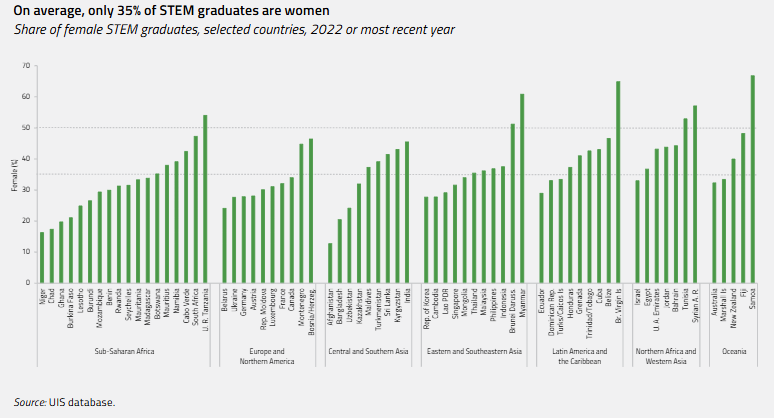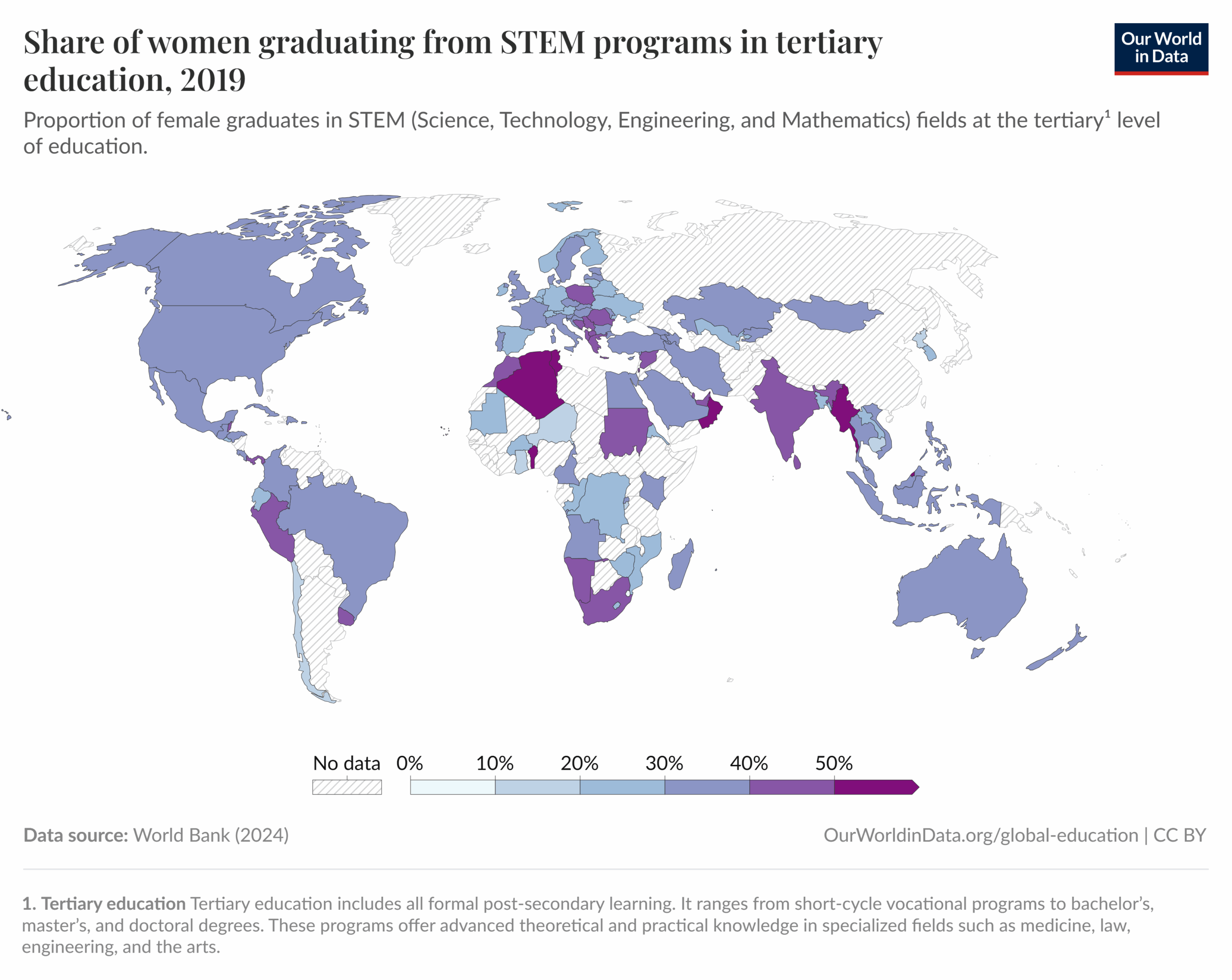While the world is seeing increasing gender inclusion across many professions, STEM (Science, Technology, Engineering, and Math) has traditionally lagged in female representation. This disparity not only limits opportunities for women but also hinders the potential for innovation and progress within these critical industries.
Understanding the challenges women face in STEM, the factors influencing participation, and why increasing female representation benefits innovation and society is crucial.
STEM is an acronym for Science, Technology, Engineering and Math, a broad field that includes occupations such as life sciences, engineering, architecture and computer sciences. This field is widely hailed as the ‘jobs of the future’, showing the fastest growth and highest pay across all industries.
Despite the field’s high regard, women make up only 28-29% of the STEM workforce, a figure that has seen minimal change over the past decade . This stagnation highlights the ongoing challenges in achieving gender parity in STEM fields.
Research from the Pew Institute showed that a typical STEM worker earns two-thirds more than those employed in other fields; and some of the highest-earning fields in STEM, such as computer science and engineering, are those with the lowest proportion of women. This kind of occupational segregation contributes to the wider gender wage gap seen across the job market.
Men vastly outnumber women in studying STEM fields in higher education, despite women earning more undergraduate degrees, on average, than men. The 2024 Global Education Monitoring Report shows that while women earn over half of all university degrees globally, they account for only 35% of STEM graduates, a figure that has remained unchanged for the past decade.

The most common barrier to women entering STEM fields seems to be attitudes and expectations that portray STEM as a masculine field, particularly during secondary schooling. Persistent societal beliefs and stereotypes portraying STEM as male-dominated discourage young women from pursuing these careers.
Research shows that girls hold themselves to a higher standard in subjects such as math, believing that they need to be exceptional to succeed in male-dominated fields. Studies have also shown that while men and women participate equally in math and science classes in secondary school, this does not translate into tertiary education, and even less so when entering the professional field.

Another barrier to women joining the STEM fields are the systemic challenges faced such as discrimination, gender pay gaps, lack of job security, and sexual harassment to name a few.
Women are underrepresented not only in STEM professions but also in the portrayal of scientists and engineers in media, textbooks, and popular culture. Male figures are disproportionately highlighted as innovators and heroes, while the contributions of women are less visible.
This lack of representation can influence young people’s perceptions of who “belongs” in STEM, making it harder for girls to see themselves in these roles. Highlighting and celebrating women’s achievements is essential to inspire the next generation and promote greater gender inclusion.
Nancy Grace Roman, the American Astronomer and ‘Mother of the Hubble Telescope’, recalled being discouraged from studying mathematics and told from a young age that “women could not be scientists”. Choosing not to listen to these voices Nancy pursued her passion, eventually completing her PhD in Astronomy and working for NASA on the now famous Hubble Telescope.
Perhaps one of the most well-known women in STEM, Marie Curie, was influential in changing the perceptions of women within the field, as well as continuing to inspire women to pursue scientific studies despite this going against supposed gender norms.
Maureen Gwinn, who is Chief Scientist for the US’ Environmental Protection Agency amongst other roles, was first introduced to the possibility of pursuing a career in science while learning about Marie Curie in elementary school. It is her goal to be a role model for the next generation, demonstrating the variety of opportunities for women within this field, but as she said “there is still work to be done”.
Elaine Weyuker experienced the difficulties of entering the STEM field in the 1960’s, when the electrical engineering building she studied in did not have a female restroom for her to use. Now a renowned software engineer, she is using her success to inspire other women and girls to enter the field, as well as conducting in-depth studies of the systemic barriers for women in STEM and proposing institutional and cultural changes to mitigate these.
Marie Curie (1867–1934) was a pioneering physicist and chemist whose work in radioactivity significantly advanced scientific understanding and challenged societal norms regarding women’s roles in science. In 1903, she became the first woman to win a Nobel Prize, sharing the Nobel Prize in Physics with her husband Pierre Curie and Henri Becquerel for their joint research on radiation phenomena. In 1911, she received the Nobel Prize in Chemistry for her discovery of the elements radium and polonium, making her the only person to have won Nobel Prizes in two different scientific fields.
Addressing the gender gap in STEM requires thoughtful, evidence-based strategies. Key approaches include:
These changes in attitude can be supported through using the Positive Peace Framework, which provides an evidence-based background for creating sustainable change. Critiquing institutions which promote stereotypes could provide inspiration for the design of new, innovative programs promoting inclusion. Aligning these programs with the Positive Peace Framework ensures sustainability and ongoing change, in these pervasive and often subconscious attitudes limiting women from participating in STEM.
As a recent AAUW paper surmised: “to diversify the STEM fields, we must take a hard look at the stereotypes and biases that still pervade our culture. Encouraging more girls and women to enter these vital fields will require careful attention to the environment in our classrooms and workplaces and throughout our culture.”
Achieving gender parity in STEM is not just a matter of fairness but also a necessity for fostering innovation and progress. By addressing the barriers that women face and implementing strategies to promote inclusion, we can create a more diverse and dynamic STEM community.
Observed annually on 11 February, the International Day for Women and Girls in Science recognises the achievements of women in scientific fields and promotes gender equality in STEM. This day serves as a reminder of the ongoing challenges women face across these industries and highlights the importance of supporting the next generation of female scientists, engineers, and technologists.
Acknowledging this day reinforces the need for: